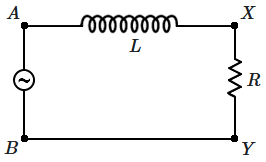Select Chapter Topics:
An AC source is rated \(220~\mathrm{V}\), \(50~\mathrm{Hz}\). The average voltage is calculated in a time interval of \(0.01~\mathrm{s}\). It,
1.
must be zero
2.
may be zero
3.
is never zero
4.
is \(220\sqrt{2}\) V
Subtopic: RMS & Average Values |
53%
From NCERT
To view explanation, please take trial in the course.
NEET 2025 - Target Batch
Hints
To view explanation, please take trial in the course.
NEET 2025 - Target Batch
An AC source rated \(100~\text{V}\) (rms) supplies a current of \(10~\text{A}\) (rms) to a circuit. The average power delivered by the source:
| (a) | must be \(1000~\text{W}\). |
| (b) | may be \(1000~\text{W}\). |
| (c) | may be greater than \(1000~\text{W}\). |
| (d) | may be less than \(1000~\text{W}\). |
| 1. | (a) only |
| 2. | (b), (c) |
| 3. | (b), (d) |
| 4. | (a), (d) |
Subtopic: Power factor |
61%
From NCERT
To view explanation, please take trial in the course.
NEET 2025 - Target Batch
Hints
To view explanation, please take trial in the course.
NEET 2025 - Target Batch
Exactly identical voltages are imposed on the system at \(X, Y,\) and \(Z:V_m \sin \omega t\). The peak voltage at \(O\) is \(V_o\). Then:

1. \(V_o = V_m\)
2. \(V_o < V_m \)
3. \(V_o > V_m\)
4. any of the above can be possible.

1. \(V_o = V_m\)
2. \(V_o < V_m \)
3. \(V_o > V_m\)
4. any of the above can be possible.
Subtopic: Different Types of AC Circuits |
From NCERT
Please attempt this question first.
Hints
Please attempt this question first.
The primary has \(100\) turns with \(100\) V rms applied to it while the secondary has a total number of \(20\) turns, with the connection \(C\) made at the centre. The current \(i\) flowing towards \(C\) has the (rms) value:

1. \(2\) A
2. \(2\sqrt2\) A
3. \(\sqrt2\) A
4. zero

1. \(2\) A
2. \(2\sqrt2\) A
3. \(\sqrt2\) A
4. zero
Subtopic: Transformer |
From NCERT
Please attempt this question first.
Hints
Please attempt this question first.
The peak voltage of the AC source is equal to:
| 1. | \(1 / \sqrt{2}\) times the rms value of the AC source |
| 2. | the value of voltage supplied to the circuit |
| 3. | the rms value of the AC source |
| 4. | \(\sqrt{2}\) times the rms value of the AC source |
Subtopic: RMS & Average Values |
76%
From NCERT
NEET - 2022
To view explanation, please take trial in the course.
NEET 2025 - Target Batch
Hints
To view explanation, please take trial in the course.
NEET 2025 - Target Batch
A series \(LCR\) circuit with inductance \(10~\mathrm{H}\), capacitance \(10~\mu F\), resistance \(50~\Omega\) is connected to an AC source of voltage, \(V=200 \sin (100 t) \text { volt }\). If the resonant frequency of the \(LCR\) circuit is \(\nu_0\) and the frequency of the AC source is \(\nu\), then:
| 1. | \(\nu=100 \mathrm{~Hz} ; ~\nu_0=\frac{100}{\pi} \mathrm{~Hz}\) |
| 2. | \(\nu_0=\nu=50 \mathrm{~Hz}\) |
| 3. | \(\nu_0=\nu=\frac{50}{\pi} \mathrm{Hz}\) |
| 4. | \(\nu_{0}=\frac{50}{\pi}~ \mathrm{Hz}, \nu=50 \mathrm{~Hz}\) |
Subtopic: Different Types of AC Circuits |
72%
From NCERT
NEET - 2022
To view explanation, please take trial in the course.
NEET 2025 - Target Batch
Hints
To view explanation, please take trial in the course.
NEET 2025 - Target Batch
An AC source given by \(V=V_m\sin\omega t\) is connected to a pure inductor \(L\) in a circuit and \(I_m\) is the peak value of the AC current. The instantaneous power supplied to the inductor is:
1. \(\frac{V_mI_m}{2}\mathrm{sin}(2\omega t)\)
2. \(-\frac{V_mI_m}{2}\mathrm{sin}(2\omega t)\)
3. \({V_mI_m}\mathrm{sin}^{2}(\omega t)\)
4. \(-{V_mI_m}\mathrm{sin}^{2}(\omega t)\)
Subtopic: Power factor |
From NCERT
NEET - 2022
To view explanation, please take trial in the course.
NEET 2025 - Target Batch
Hints
To view explanation, please take trial in the course.
NEET 2025 - Target Batch
A household ac circuit has an applied voltage of \(220\) V (RMS) and the current flowing through the circuit is \(2.2\) A (RMS), the phase difference between them being \(60^\circ.\) Then:
| 1. | the impedance in the circuit is \(100~\Omega.\) |
| 2. | the resistance in the circuit is \(200~\Omega.\) |
| 3. | the power dissipated is \(484\) W. |
| 4. | all the above are true. |
Subtopic: Different Types of AC Circuits |
54%
From NCERT
Please attempt this question first.
Hints
Please attempt this question first.
An alternating emf (ac) is applied across the circuit shown in the figure. Let \(V_{AX}\) be the voltage across the inductor \(L,\) and \(V_{XY}\) be the voltage across the resistor \(R.\) Let the angular frequency be \(\omega.\) The phase difference between \(V_{XY}\) and \(V_{AX}:\)


| 1. | depends on the ratio \(\frac{\omega L}{R}\) |
| 2. | depends on the quantity \(\sqrt{(\omega L)^2+R^2}\) |
| 3. | depends on \(L\) and \(R,\) but not on \(\omega\) |
| 4. | is independent of \(L,R,\omega\) |
Subtopic: Different Types of AC Circuits |
From NCERT
Please attempt this question first.
Hints
Please attempt this question first.
Two circuits: \((1)\) an \(L\text-R\) circuit and \((2)\) an \(R\text-C\) circuit are driven by the same alternating current. The phase difference between the current and the voltage is twice in the \(1\)st case with respect to the \(2\)nd case and both the angles add up to \(90^\circ.\) The resistances are equal in both cases. The ratio of their reactances (first: second) is:
1. \(\sqrt3:1\)
2. \(1:\sqrt3\)
3. \(3:1\)
4. \(2:1\)
1. \(\sqrt3:1\)
2. \(1:\sqrt3\)
3. \(3:1\)
4. \(2:1\)
Subtopic: Different Types of AC Circuits |
62%
From NCERT
Please attempt this question first.
Hints
Please attempt this question first.


